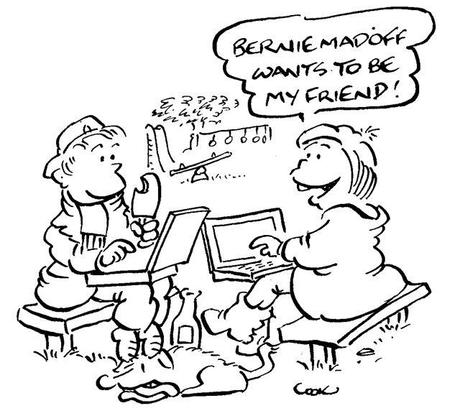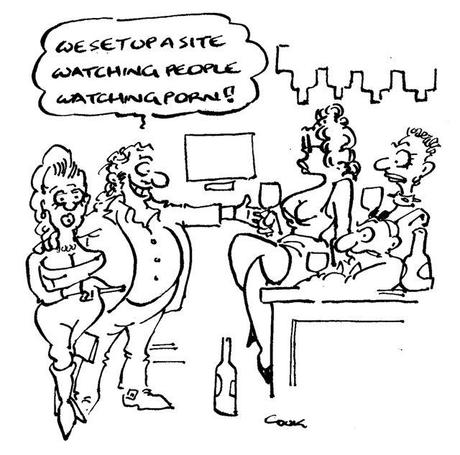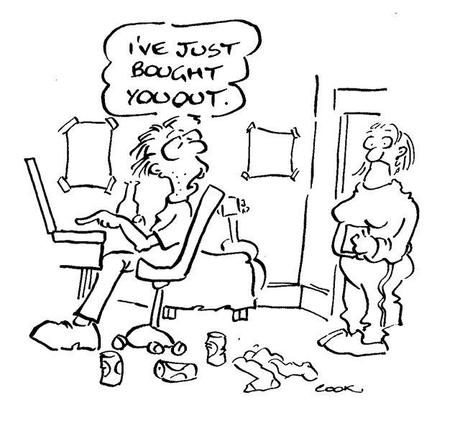Warning: about making money on the internet; if not interested, read no further
The only thing free about the internet is the method of delivery. Everything else costs – be it your internet connection, or the free downloads you put up to encourage engagement, or the time you put into making it happen. None of that is free.
 That’s a good thing. It means that commercial principles still apply. It means that anyone who understands how to run a business can probably make the internet work for them.
That’s a good thing. It means that commercial principles still apply. It means that anyone who understands how to run a business can probably make the internet work for them.
Like any marketing campaign, nobody knows if it worked until the results are in. That’s why monitoring return on investment (ROI) is so important. It lets you know whether your investment is creating value or destroying it.
Most writing about ROI in social media is either blather or common sense. It might be about “engagement”, but if you haven’t worked that out in the first five minutes, you need to go back to marketing 101.
All marketing is about engagement.
Here’s a theoretical example. Think of Google Adwords, or the Facebook equivalent, as a letterbox drop for, say, a local coffee shop. You design a flyer that attracts a buyer. You target a community, probably your local postcode. You add an enticement like a coupon offering two cups for the price of one.
You focus on customer service. You ensure the experience of transacting at your coffee shop is a positive one. You offer them a loyalty card for their trouble. They leave knowing that after nine more cups, they’ll get the 10th one free.
 If that all goes right, you have just bought a new customer. You’ve engaged them in your community. If they responded to the campaign and became loyal customers, they’ll buy 10 cups of coffee and you’ll give them two free ones – one for the coupon and one on the loyalty card.
If that all goes right, you have just bought a new customer. You’ve engaged them in your community. If they responded to the campaign and became loyal customers, they’ll buy 10 cups of coffee and you’ll give them two free ones – one for the coupon and one on the loyalty card.
What did it cost you? The fact that you have “bought” your customer means you can work out your ROI. The cost of the flyer, its delivery, and the free cups of coffee add up to your investment.
For the return to be positive it has to jump just one hurdle. It has to have cost less than you spent. So how much money have you got available to spend on buying a new customer?
That’s a matter of working out your variable profit margin and it’s not rocket science.
A simple example
First of all, ignore all your fixed costs. After all, they’re fixed. In the earlier example, one more cup of coffee won’t affect them. The amount you incur in milk and coffee beans will.
Say you sell a cappuccino (or any product, online or in the mall) for $4 and making an extra one costs $2. That’s your variable cost. Your variable profit margin (VPM) is the price minus variable cost, so it’s $2.
In our earlier example, a “bought” customer may buy up to 10 cups, via coupon and loyalty card. At $2 VPM per cup, that’s generates $20. That’s how much money you’ve got available to buy each new customer. Spend more than that on the campaign and your ROI is negative. Spend less, it’s positive. Spend exactly that amount and it’s a breakeven exercise.
So the formula for monitoring ROI is pretty simple:
- ROI = VPM X Additional Cups Sold – Cost of Campaign.
In our example, say the campaign generates 50 new customers and costs $800, including the free coffees. Then,
- ROI = $20 X 50 - $800 = $200.
So you’ve made $1000 in sales and you’ve spent $800. Your profit is $200. In percentage terms that’s an ROI of 25%.
This is basic common sense
Business principles don't change just because you use the net. The number you have to work out is how much money you have available to buy new customers – how much VPM they bring in.
 Work that out and you now know what budget you’ve got available to spend on creating an online community, running a click campaign, producing free downloads, making a video, providing discounts for online purchases or generating new members for your site.
Work that out and you now know what budget you’ve got available to spend on creating an online community, running a click campaign, producing free downloads, making a video, providing discounts for online purchases or generating new members for your site.
Nothing has changed because it’s web-based, except that you won’t be paying the post office to deliver the message. That’ll be free. It will still be up to you to keep the customer, but that’s about maintaining your community, not growing it.
Social media and internet marketing campaigns are exciting, but they destroy value if they don’t produce positive results. Hits on the site are one thing; money in the bank is another.
This is not about sending the fun police into the exciting social media environment. It’s just applying basic business principles to make sure it works.
People who make money on the internet use business principles – either taught or intuitive – to create value. Try working out the actual return on your online costs. What investment do you have to make to build your tribe and what return do you get from it?

Like any marketing campaign, nobody knows if it worked until the results are in. That’s why monitoring return on investment (ROI) is so important. It lets you know whether your investment is creating value or destroying it.
Most writing about ROI in social media is either blather or common sense. It might be about “engagement”, but if you haven’t worked that out in the first five minutes, you need to go back to marketing 101.
All marketing is about engagement.
Here’s a theoretical example. Think of Google Adwords, or the Facebook equivalent, as a letterbox drop for, say, a local coffee shop. You design a flyer that attracts a buyer. You target a community, probably your local postcode. You add an enticement like a coupon offering two cups for the price of one.
You focus on customer service. You ensure the experience of transacting at your coffee shop is a positive one. You offer them a loyalty card for their trouble. They leave knowing that after nine more cups, they’ll get the 10th one free.

What did it cost you? The fact that you have “bought” your customer means you can work out your ROI. The cost of the flyer, its delivery, and the free cups of coffee add up to your investment.
For the return to be positive it has to jump just one hurdle. It has to have cost less than you spent. So how much money have you got available to spend on buying a new customer?
That’s a matter of working out your variable profit margin and it’s not rocket science.
A simple example
First of all, ignore all your fixed costs. After all, they’re fixed. In the earlier example, one more cup of coffee won’t affect them. The amount you incur in milk and coffee beans will.
Say you sell a cappuccino (or any product, online or in the mall) for $4 and making an extra one costs $2. That’s your variable cost. Your variable profit margin (VPM) is the price minus variable cost, so it’s $2.
In our earlier example, a “bought” customer may buy up to 10 cups, via coupon and loyalty card. At $2 VPM per cup, that’s generates $20. That’s how much money you’ve got available to buy each new customer. Spend more than that on the campaign and your ROI is negative. Spend less, it’s positive. Spend exactly that amount and it’s a breakeven exercise.
So the formula for monitoring ROI is pretty simple:
- ROI = VPM X Additional Cups Sold – Cost of Campaign.
In our example, say the campaign generates 50 new customers and costs $800, including the free coffees. Then,
- ROI = $20 X 50 - $800 = $200.
So you’ve made $1000 in sales and you’ve spent $800. Your profit is $200. In percentage terms that’s an ROI of 25%.
This is basic common sense
Business principles don't change just because you use the net. The number you have to work out is how much money you have available to buy new customers – how much VPM they bring in.

Nothing has changed because it’s web-based, except that you won’t be paying the post office to deliver the message. That’ll be free. It will still be up to you to keep the customer, but that’s about maintaining your community, not growing it.
Social media and internet marketing campaigns are exciting, but they destroy value if they don’t produce positive results. Hits on the site are one thing; money in the bank is another.
This is not about sending the fun police into the exciting social media environment. It’s just applying basic business principles to make sure it works.
People who make money on the internet use business principles – either taught or intuitive – to create value. Try working out the actual return on your online costs. What investment do you have to make to build your tribe and what return do you get from it?

